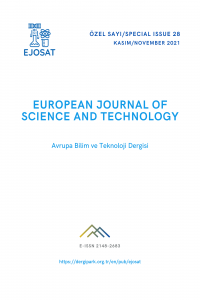Destek Vektör Makineleri ve Gauss Süreçleri Kullanılarak Sınırlı İklim Değişkenlerinden Referans Evapotranspirasyon Tahmini
Abstract
Türkiye'nin tüm bölgelerine eşit olarak dağılmış hava istasyonlarından toplanan iklim değişkenleri, Gaussian Proses Regresyon (GPR) ve Destek Vektör Regresyonunun (SVR) referans evapotranspirasyonu (ET0) tahmin etme potansiyelini incelemek için kullanılmıştır. GP ve SVR modelleri için girdi özellikleri olarak kullanılan değişkenler güneş radyasyonu, ortalama sıcaklık, rüzgar hızı, bağıl nem ve yılın ayıdır. Karşılık gelen ET0 değerleri, aynı istasyonlardan toplanan iklim ölçümleri kullanılarak Gıda ve Tarım Örgütü tarafından önerilen FAO 56 PM denklemi kullanılarak hesaplanmıştır. Sonuçlar, GPR ve SVR modelleri kullanılarak yüksek doğruluğa sahip regresyon modellerinin mümkün olduğunu göstermektedir. ET0 tahmini için en etkili girdi değişkeninin güneş radyasyonu olduğu bulunmuştur. Bağıl nem, model doğrulukları üzerinde en düşük etkiye sahiptir.
References
- Droogers, P., Allen, R. G., Estimating reference evapotranspiration under inaccurate data conditions. Irrigation and Drainage Systems, 16: 33–45, 2002.
- Allen, R. G., Pereira, L. S., Raes, D., Smith, M., Crop evapotraspiration guidelines for computing crop water requirements. FAO Irrigation & drainage Paper 56. FAO, Food and Agriculture Organization of the United Nations, Roma, 50 pp, 1998. Hargreaves, G. H., Samani, Z. A., Reference Crop Evapotranspiration From Temperature. American Society of Agricultural Engineers, 96–99, 1985.
- Xu, C. Y., Singh, V. P., Cross comparison of empirical equations for calculating potential evapotranspiration with data from Switzerland. Water Resources Management, 16 (3): 197–219, 2002.
- Nourani, V., Hosseini Baghanam, A., Adamowski, J., Kisi, O., Applications of hybrid wavelet-Artificial Intelligence models in hydrology: A review. Journal of Hydrology, 514: 358–377, 2014.
- Chia, M. Y., Huang, Y. F., Koo, C. H., & Fung, K. F., Recent advances in evapotranspiration estimation using artificial intelligence approaches with a focus on hybridization techniques—a review. Agronomy, 10(1), 101, (2020).
- Citakoglu, H., Cobaner, M., Haktanir, T., Kisi, O., Estimation of Monthly Mean Reference Evapotranspiration in Turkey. Water Resources Management, 28 (1): 99–113, 2014.
- Wen, X., Si, J., He, Z., Wu, J., Shao, H., & Yu, H., Support-Vector-Machine-Based Models for Modeling Daily Reference Evapotranspiration With Limited Climatic Data in Extreme Arid Regions. Water Resources Management, 29 (9): 3195–3209, 2015.
- Carter, C., Liang, S., Evaluation of ten machine learning methods for estimating terrestrial evapotranspiration from remote sensing. International Journal of Applied Earth Observation and Geoinformation, 78 (October 2018): 86–92, 2019.
- Yu, H., Wen, X., Li, B., Yang, Z., Wu, M., & Ma, Y., Uncertainty analysis of artificial intelligence modeling daily reference evapotranspiration in the northwest end of China. Computers and Electronics in Agriculture, 176, 105653, 2020.
- Özkaya, U., Öztürk, Ş., Gaussian Regression Models for Day-Level Forecasting of COVID-19 in European Countries. In Understanding. COVID-19: The Role of Computational Intelligence, 2022, pp. 339-356, Springer, Cham.
- Özkaya, U., Yiğit, E., Seyfi, L., Öztürk, Ş., Singh, D., Comparative Regression Analysis for Estimating Resonant Frequency of C-Like Patch Antennas. Mathematical Problems in Engineering, 2021.
Reference Evapotranspiration Prediction from Limited Climatic Variables Using Support Vector Machines and Gaussian Processes
Abstract
Climatic variables collected from weather stations evenly distributed in all regions of Turkey were used to study the potential of Gaussian Process Regression (GPR) and Support Vector Regression (SVR) in predicting reference evapotranspiration (ET0). The variables used as input features for the GPR and SVR models were solar radiation, mean temperature, wind speed, relative humidity, and month of the year. The corresponding ET0 values were calculated using the Food and Agriculture Organization recommended equation FAO 56 PM using climatic measurements collected from the same stations. Results show that regression models with high accuracies are possible using GPR and SVR models. The most effective input variable for ET0 prediction was found to be solar radiation. Relative humidity had the lowest impact on model accuracies.
References
- Droogers, P., Allen, R. G., Estimating reference evapotranspiration under inaccurate data conditions. Irrigation and Drainage Systems, 16: 33–45, 2002.
- Allen, R. G., Pereira, L. S., Raes, D., Smith, M., Crop evapotraspiration guidelines for computing crop water requirements. FAO Irrigation & drainage Paper 56. FAO, Food and Agriculture Organization of the United Nations, Roma, 50 pp, 1998. Hargreaves, G. H., Samani, Z. A., Reference Crop Evapotranspiration From Temperature. American Society of Agricultural Engineers, 96–99, 1985.
- Xu, C. Y., Singh, V. P., Cross comparison of empirical equations for calculating potential evapotranspiration with data from Switzerland. Water Resources Management, 16 (3): 197–219, 2002.
- Nourani, V., Hosseini Baghanam, A., Adamowski, J., Kisi, O., Applications of hybrid wavelet-Artificial Intelligence models in hydrology: A review. Journal of Hydrology, 514: 358–377, 2014.
- Chia, M. Y., Huang, Y. F., Koo, C. H., & Fung, K. F., Recent advances in evapotranspiration estimation using artificial intelligence approaches with a focus on hybridization techniques—a review. Agronomy, 10(1), 101, (2020).
- Citakoglu, H., Cobaner, M., Haktanir, T., Kisi, O., Estimation of Monthly Mean Reference Evapotranspiration in Turkey. Water Resources Management, 28 (1): 99–113, 2014.
- Wen, X., Si, J., He, Z., Wu, J., Shao, H., & Yu, H., Support-Vector-Machine-Based Models for Modeling Daily Reference Evapotranspiration With Limited Climatic Data in Extreme Arid Regions. Water Resources Management, 29 (9): 3195–3209, 2015.
- Carter, C., Liang, S., Evaluation of ten machine learning methods for estimating terrestrial evapotranspiration from remote sensing. International Journal of Applied Earth Observation and Geoinformation, 78 (October 2018): 86–92, 2019.
- Yu, H., Wen, X., Li, B., Yang, Z., Wu, M., & Ma, Y., Uncertainty analysis of artificial intelligence modeling daily reference evapotranspiration in the northwest end of China. Computers and Electronics in Agriculture, 176, 105653, 2020.
- Özkaya, U., Öztürk, Ş., Gaussian Regression Models for Day-Level Forecasting of COVID-19 in European Countries. In Understanding. COVID-19: The Role of Computational Intelligence, 2022, pp. 339-356, Springer, Cham.
- Özkaya, U., Yiğit, E., Seyfi, L., Öztürk, Ş., Singh, D., Comparative Regression Analysis for Estimating Resonant Frequency of C-Like Patch Antennas. Mathematical Problems in Engineering, 2021.
Details
| Primary Language | English |
|---|---|
| Subjects | Engineering |
| Journal Section | Articles |
| Authors | |
| Publication Date | November 30, 2021 |
| Published in Issue | Year 2021 Issue: 28 |

